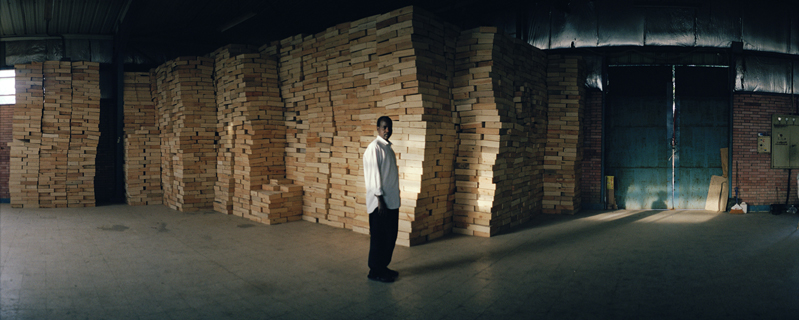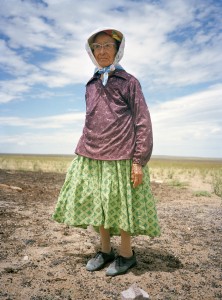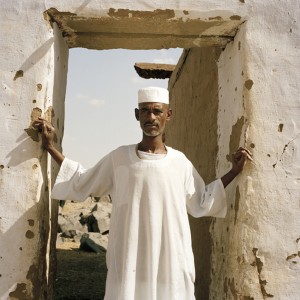Portraits of Real People
Photographer Myriam Abdelaziz is currently exhibiting from June to September 2010, at the BOZAR Center for Fine Arts in Brussels, Belgium as well as at the National Gallery in Cape Town, South Africa. French, of Egyptian origins, she started her professional photography several years ago, giving up an already successful career in the marketing industry. After exhibiting some of her work in Paris in 2004, she took on advanced studies in documentary photography and graduated from the International Center of Photography in 2006. While she continued exhibiting in galleries in Europe and the States, she received a nomination for the New York Photo Festival Award in May 2008, and published a book based on the theme of her exhibition, ‘Portrait of a Genocide’. This exhibition took place at the United Nations Headquarters in New York in August 2008. Ms Abdelaziz won several competitions over the last four years and was nominated by the Magenta Foundation as one of the 25 Emerging Photographers in the USA in 2009.

Could you tell us a little bit more about your latest exhibition in Brussels, entitled “A Useful Dream”. The exhibition ‘A Useful Dream’, curated by Simon Njami, is a celebration of African photography. It is the means to an accurate representation of the continent and its current economical and political situation from the perspective of photographers of African origin. This collection of works is meant to give insight into the people, their culture, their values and their traditions which contrast with the stereotypical exotic photographs from foreign photographers.
Do you still get the same thrill, the same emotions, when you are about to open an exhibition, as you did when you first started? Yes I do. Every exhibition is unique… the experience, the theme, the setting, everything makes an exhibition thrilling. It’s never the same. You never know how people are going to react to your photographs. The thrill, anxiety and excitement of the opening night are always part of the process. Getting to take the shots, see my work on a wall, remember the moment and share it with others brings me, after the overwhelming surge of anxious emotions, a great satisfaction, and if the crowd understood my photography, success. If that thrill vanished, if those emotions disappeared, if I lost that feeling of satisfaction and success, I know I will have to think of doing something else.
Why did you decide to leave the marketing industry and venture into photography? Photography was the only thing that really made sense in my life at that time. I was already contemplating the idea and had already participated in an exhibition in Paris while working full-time. It was only when I sold my first two photographs that I felt I needed to dedicate myself completely to it. It was a sign. 
Why did you choose portraiture as your speciality? I didn’t choose, it just came to me… I try to work ‘inside out’, meaning that ‘where I am drawn’ and ‘when I feel the moment’, I take the photograph without ever questioning it. My first studies in photography were based on documentary reportages. I went with it, tried to work with it, but I found myself drawn to people, and my photographs slowly but surely evolved into that direction. I discovered the joy of meeting new people, and the curiosity that entices me to learn more about their cultures, values and principles.
What, according to the photographer inside you, makes THE perfect portrait? I don’t believe in perfection, but I can say that a strong portrait is one which captures an instant of life, a moment when something inner is revealed, a glimpse of a soul…an intimate moment. 
Do you ask your characters to pose for you or do you take the shots in the spur of the moment? If they pose, they wouldn’t be comfortable, and it wouldn’t be natural. I prefer taking the photographs on the spur of a moment so I can let them be who they really are. The photograph becomes then a clear vision into the individual and his soul. I am an observer not a director. Photographs are very personal things, and I don’t like disturbing people. I consider it a great privilege that they let me take their photographs so I am not about to order them as to how they should stand or what they should look at.
What is it that has mostly left a mark in you while going travelling around the world for your projects? The people I meet and the conversation we have. I have learned a lot about myself through them, each and every single time. Meeting new people in their own world, however brief and/or short the time spent there, is also precious. They are all unique. The simple process of slowing down to stop and give them a chance to connect with me, and me with them, is also very enriching.
What is the most difficult part of becoming a professional photographer? Being a professional photographer can be quite difficult. You have to believe in yourself and in your craft, so you don’t give up. You need to maintain a certain rhythm of production as well as feel strong about the projects you take in hand. With time, and especially at the beginning, you do realize that stability and security are luxury if you don’t work hard at it. Confidence and persistence are key.
Who is your favourite professional photographer? Too many to mention but I particularly enjoy the works of Helmut Newton, Erwin Olaf, and Andres Serrano.

- Myriam © Myriam Abdelaziz 2008
Myriam’s “Going South” collections of portraits from the Egyptian country side are an insight into the traditions and culture of the current Egyptian rural civilization. Each individual’s personality emanates from the photograph, with a glimpse of genuine kindness and generosity we can expect from such characters. “Darfuris in Cairo” illustrates hard labour and tough times for a population that tries to fit into the Egyptian capital. In contrast with the people from the countryside, they aren’t smiling, they ‘seem to’ have accepted their situation and their social status, the precarious housing facilities, and hard end-of-the-line occupations. They seem to be waiting, patiently, for something to change.
Leaving the African continent and going into North America, “On Navajoland” is also about people, but not about your typical American citizen. It’s about people with a different identity, yet somewhat similar living conditions as the Egyptian folk from the country side. Their wide spread land, similarly rich in culture and traditions is no stranger to poor living conditions. Yet, they are smiling, welcoming and warm, untouched by corruption and pollution, slightly influenced by modern civilization, they find wealth in their surroundings and their communities. They have found a way to merge modern times with their own historical genuine identity.
Myriam’s photographs are a window into other parts of the world. They are a voyage in space and time. They are an escape to the foreverland of forgiveness and simplicity, where kindness and warmth, however hard the conditions, still prevail. She successfully manages to capture through her lens, the presence of modern civilisation into isolated cultures which result in unusually rich photographs of individuals with something to say. Simply Delightful!
For further information, please visit www.myriamabdelaziz.com or contact Myriam Abdelaziz at [email protected]

Responses